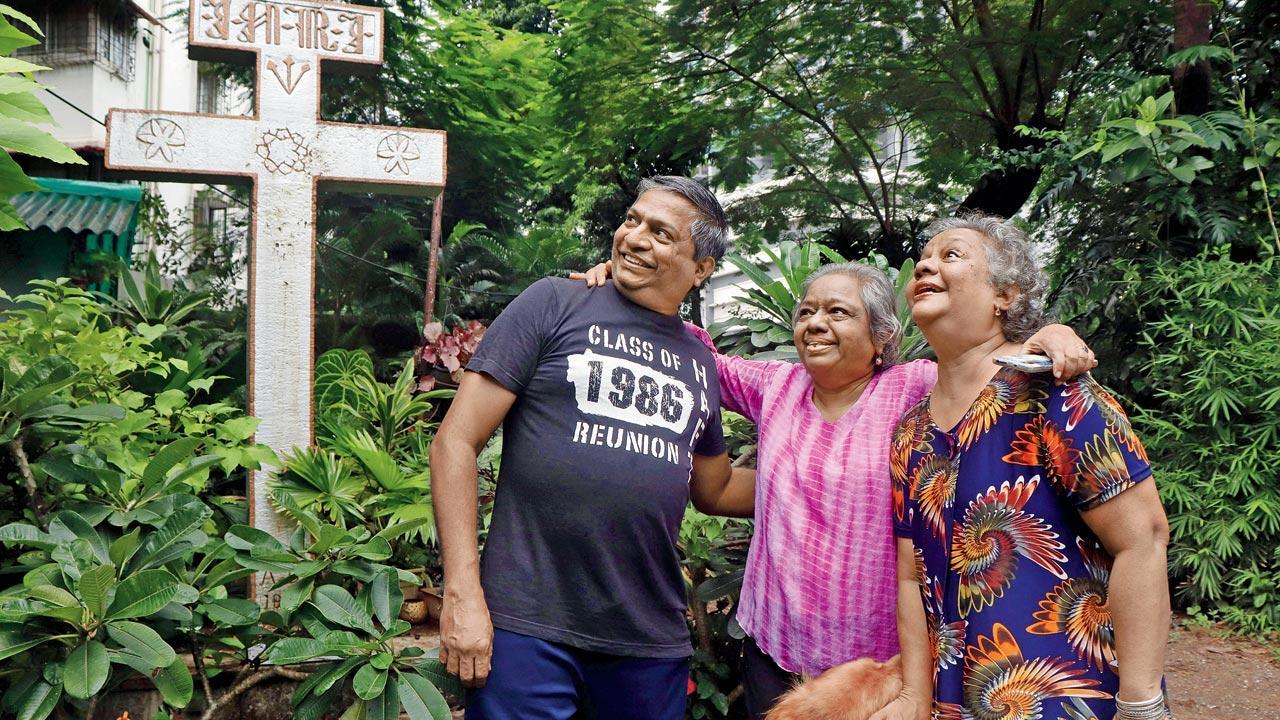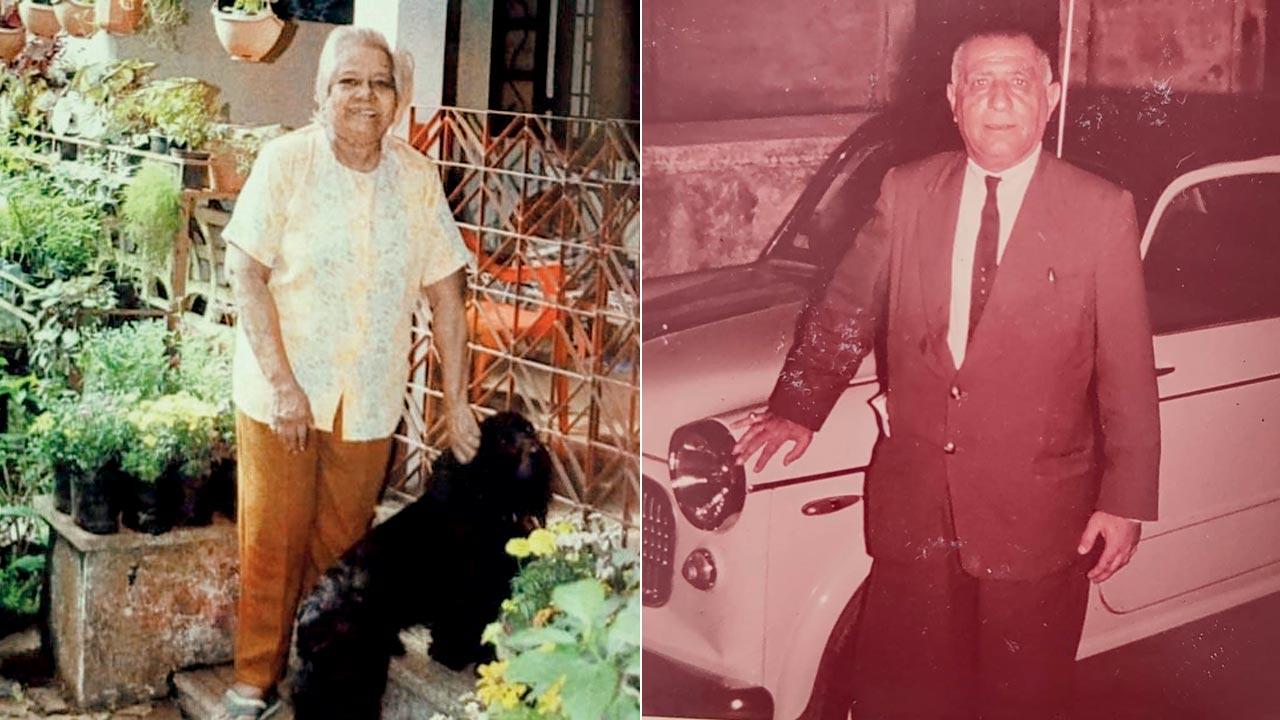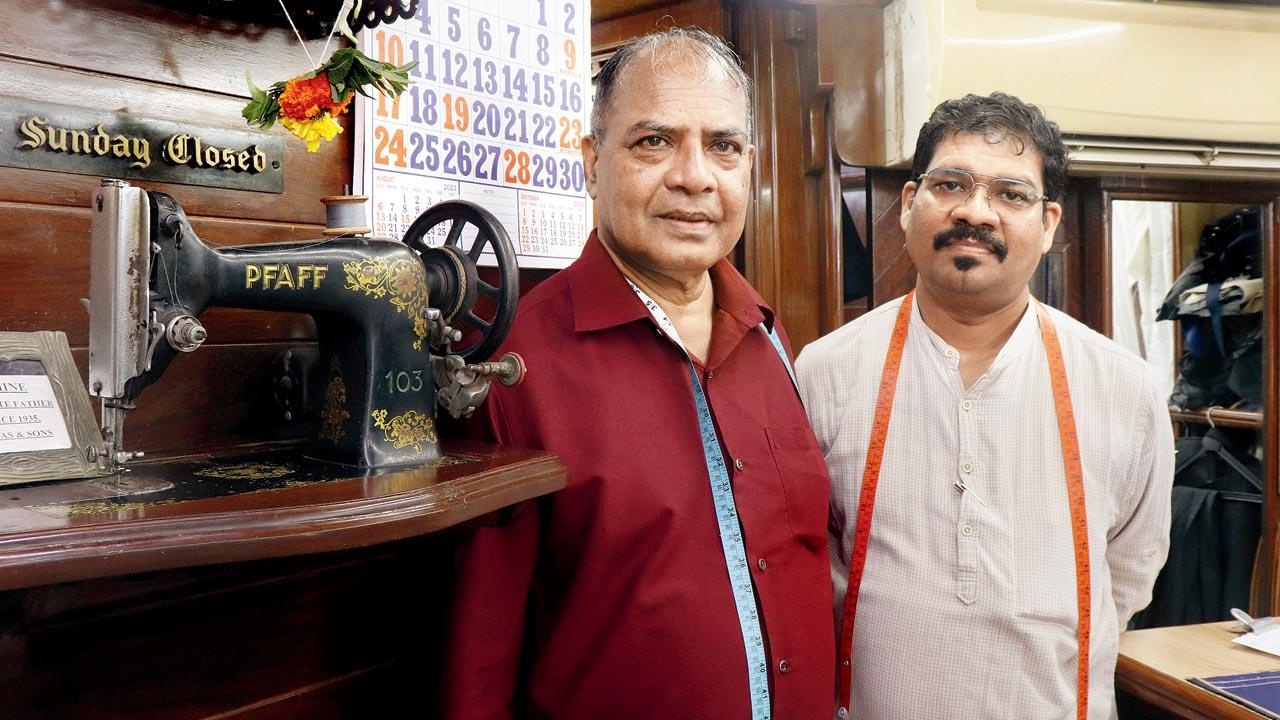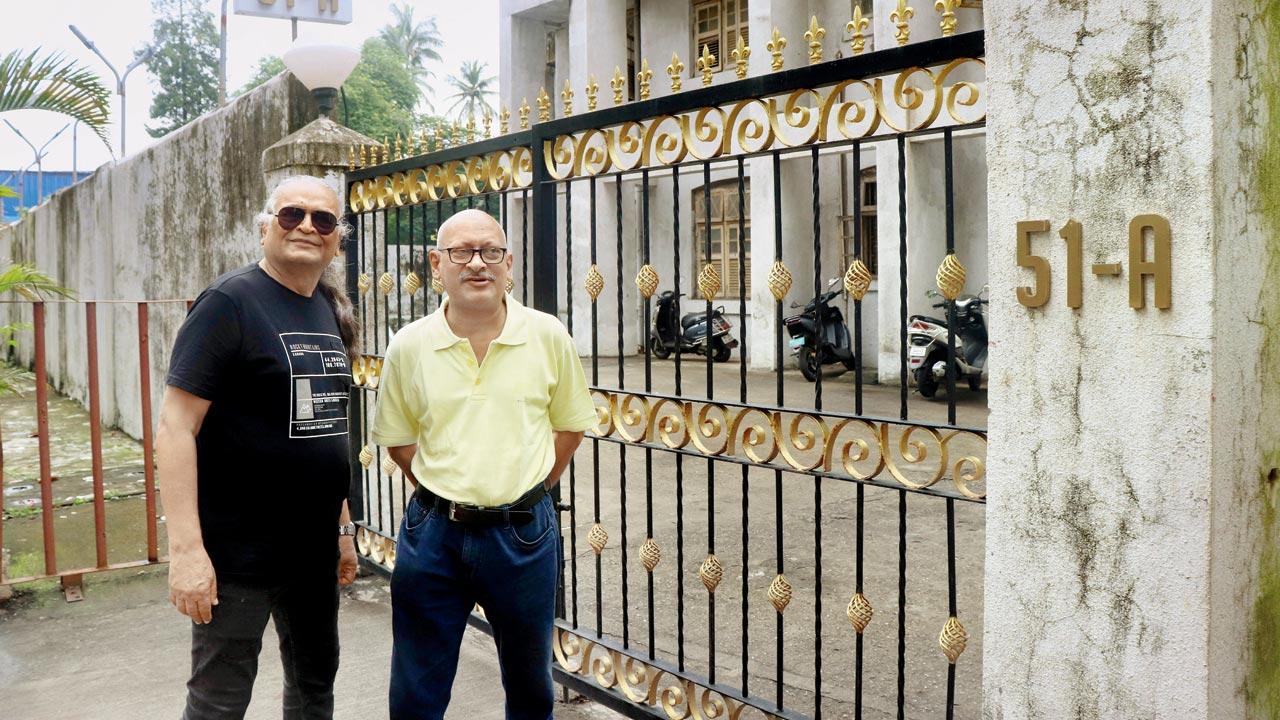What was a central little suburban lane like with life centred around the factory naming it?

Jennifer D’Souza and Bernadette Cardoz with their brother Andrew D’Souza near the 1866 Resurrection Cross in their garden. Most Bandra crosses were erected when the 1896 plague decimated the population. Pics/Anurag Ahire
 Ice Factory. Hearing the words, SoBo-ites will likely shoot back with, “Ah, at Ballard Estate.” They refer to the part of Calicut Road there, sprouting tony new restaurants and party venues. Far, far from the Ice Factory Lane abutting my childhood Bandra home.
Ice Factory. Hearing the words, SoBo-ites will likely shoot back with, “Ah, at Ballard Estate.” They refer to the part of Calicut Road there, sprouting tony new restaurants and party venues. Far, far from the Ice Factory Lane abutting my childhood Bandra home.
At the centre of Hill Road, my Deco residence—Trio’s shopping complex-cum-tower today—shared a low west wall with Bambi Laundry. Our east brushed Boman House, where Ardeshirji from Nasrabad in Yazd, laid Bombay roots in 1949. The wide teak doors of that bungalow were fronted by a porch where my mother sometimes sat chatting with Ardeshir’s wife Khorshed Banoo.
Hard to imagine a once pastoral Hill Road. Snakes slithered in meadows where Elco Arcade stands. Goat flocks were trotted to the abattoir, then beside the railway station. Our home faced Almeida Road (the street and park honouring botanist Raphael Almeida), down which trundled bullocks in bail gaadis pulling giant sawdust-covered ice slabs to the factory behind our house. The swoosh of H2O falling in silver sheets day and night was soothing. The factory also sprang an ammonia leak emergency one dawn, rushing us out in pyjamas to huddle on Hill Road, all terrified together.
 The late Marie D’Souza at the Ed-Mar gate with spaniel Nemo; (right) Rustomji Irani who co-founded the ice factory after World War II
The late Marie D’Souza at the Ed-Mar gate with spaniel Nemo; (right) Rustomji Irani who co-founded the ice factory after World War II
Reliving that panic in the pit of the stomach 50 whole years later, I mention the incident to Rustom Irani, managing director of Icelings, who elaborates on the factory’s establishment. “My grandfather, Rustom Gustasp Irani, was in the ‘soda-lemon’ business [goti soda bottles held the carbonated lemon drink the Brits popularised] ahead of starting the factory, after World War II ended, on a plot owned by the Hormuzdi family. His partner was Zerbanoo Gifford’s father, Bailey [Behram] Irani. Subsequently emigrating to England, Bailey opened the Heritage Hotel at Bayswater in London and was founder president of the World Zoroastrian Organisation. My Khodu Kaka, who had a chickoo wadi in Dahanu, looked after the factory, which I ran for a few years.”
The Hormuzdis’ sandstone villa, West View, veiled by palm trees and paan vines, harboured the craziest menagerie. A parrot swore, “M****, darvajo kholo!” at every doorbell ring that was delayed being answered. His expletives rang through the sprawling flat of Shirinbai and Sheriar Hormuzdi, with fish tanks, the monkeys Tarabai and Sitaram, and even a leopard inexplicably christened Tiger. Not forgetting Brownie, the Silky Sydney, a carnival dog who puffed cigars, a stylish trick he was circus-trained at.
Across West View stood the 1937-built home of the Kutars who hailed from Navsari like my Dastoor ancestors. Phiroze Kutar’s family came to Bandra around 1939. His father, Darab Faramroze Kutar, attached to the Tata Agiary on Hill Road, was appointed its head priest in the 1950s. Phiroze worked as a wireman in Swadeshi Mills and a despatch rider with the Home Guards. “The landscape was lush with coconut, imli and bora trees,” says his son Kaizad. “Dad would speak of a pond for visiting circus animals to drink from.”
 Francis Dias and nephew Saby Dias at 1930-established SS Dias Tailors
Francis Dias and nephew Saby Dias at 1930-established SS Dias Tailors
Next to the Kutars were the Lutchmayers. First arriving at the age of five in 1974, British-Goan concert pianist Karl Lutchmayer spent two weeks here every other year until 1984. Before boarding any flights to the UK, the Lutchmayers headed to the factory to weigh suitcases, using the old-fashioned spring-loaded hanging scale weighing ice. Karl recollects damp gunny lying about to sheath the ice, with its very particular smell.
Also read: A Road to a Village
“Transfixed, I’d watch the cook prepare lunch for my aunt Josephine who worked for Air France at the Taj. The dabbawala seemed, by magic, to know how to get the meal to her,” he marvels in an email interview. “Afternoon tea done, we strolled in the car-free streets, dropping in on neighbours to look at curios and photos. A convivial, elegant way to live. Returning to England, my parents convinced me we couldn’t do likewise, just turn up unannounced at neighbours’ homes.
“But let’s not make this too halcyon. There was a mother with three children on the pavement. Neighbours ensured they had food. They sheltered on our verandah in the monsoon. Those children made amazing lives. One, a trained professional dancer, got in touch last year and we met up. That too is an Ice Factory Lane story.”
 Kaizad Kutar (right) at 51-A with Loy Henriques of Andrew Villa
Kaizad Kutar (right) at 51-A with Loy Henriques of Andrew Villa
The quintessential story, though, is that of the D’Souzas in Ed-Mar cottage tucked deep within the lane. Four years ago, I had met Marie D’Souza, grande dame of the gully, whose forebears bequeathed Bandra a progressive legacy. Pointing to where the lane intersects Bazar Road to swerve into Boran village, Marie’s daughter Jennifer recollects a breezy road and the sound of water crashing heavily against rocks near Ed-Mar (twinning the parents’ names, Edmund and Marie), built in 1951.
“The cross in our garden is from 1866,” she explains. “Most Bandra crosses were erected when the 1896 plague decimated the population. This is a resurrection cross, after Jesus rose from the dead. Notice the nails and crown without the figure of Christ. It was put up by my grandfather Ignatius or his ancestors.”
I read about them in Ignatius D’Monte’s daughter Marie’s notes in a journal describing the vicinity’s “serene and salubrious air, with marble mansions, spacious villas and whitewashed, red-roofed cottages in formal fruit and flower gardens”. A fluent public speaker, her father was active in church and community matters, and as a responsible landowner, interested in civic affairs. “Not surprisingly, he decided to stand for public office. Becoming President of the Bandra Municipality several times, he served as a dedicated Councillor. During his tenure the mutton market was renovated. He helped Bandra get gas lighting, followed by electric lighting. With our long shoreline, he improved seaward areas, making them safe for people to walk.
“The Governor of Bombay came to inaugurate social functions. IG, as my father was affectionately called, was usually on the reception committee. The Bandra fisherfolk counted him their friend and mediator when they had arguments with the clergy, which was often. We lived a good life, complete with horse and carriage. Never one of the new motor cars coming in, sported by the well-to-do. In the 1930s, he joined the Swadeshi movement, earning the disapproval of Christians who were largely pro-British.”
I watch, amused, as Cruffin the cat (delectable hybrid of “croissant” and “muffin”) curls in the sun on a swing amid the cool garden green, but Luna, the D’Souzas’ other pet feline, chases a hopping magpie robin. Jennifer’s brother David tells me Rosemary Apartments, De Joss and Andrew Villa are constructed over what were wild, open fields for local lads like him playing football, volleyball and hockey.
Though David and Jennifer’s sister Bernadette is away for the weekend, I climb a floor to meet her father-in-law, Roland Cardoz, who quips, “We never lacked for bombil, bora berries and baraf blocks. And grog.” In another wicked whisper, he adds, “I’m actually 39, not 93! I must say this lane once had everything. Ice from the factory, ‘Naughty Boy’ black shoes from Bata and plenty of banks, provided you had money in your account.”
Both Bata showroom and landmark factory are missing. As is Bambi Laundry, situated in the same compound as ours. Its genial, ruddy-cheeked proprietor Raymond Pinto, who named the enterprise for his daughter Bambi (real name Sheila), loved children. Waving as their school bus slowed at the spot, their shoutout, “Uncle Pinto, Uncle Pinto”, was invariably rewarded with gooey caramel toffees.
Conservation architect David Cardoz (Roland’s son) points out the posts to which boats moored are still seen, Boran being a protected fishing port. “The ice factory existed because of fish. The gully was known as Bombil Wadi because of Bombay duck drying rowed on the ground. Dig down, you’ll find sand and shells. A planned box drainage system ran alongside the factory. Buildings like Beau Pride partially blocked off the pipes and residents today pay water tankers. Ironic, destroying natural sources and sliding from sufficiency to dependence.”
At the corner opposite Beau Pride, Bandra’s oldest tailoring establishment welcomes customers in Bindiya Cooperative Society—SS Dias, outfitters for Air India, British Airways and Gulf Air. The shop initials are those of its original proprietor, Sebastian Salvador Dias from Loutolim. “Bandra had mainly Catholics and Parsis, so Western men’s wear was in demand, especially towards Christmas,” reasons his son Francis. My eyes feast on such antique delights as a vintage Pfaff 103 sewing machine. Francis’ nephew Saby proudly informs that Mohammed Rafi and Manna Dey trusted Dias alone to stitch them impeccably cut safari suits.
While SS Dias faces Hill Road, the family lived in rooms along the flank of Bindiya building which faced the ice factory. A door away stayed Felix Rodericks, father of couturier Wendell Rodricks. “Felix was from Colvale, the village in Bardez my mother came from,” says Francis. “As boys we saw amla, gulmohar, mango and mayflower trees around. Sadly, no more.”
He seems to echo a thought from the Month’s Mind card of Marie D’Souza: “The finest things in life are free—the air, the rain, the sea/Enjoy them while they are around—before they charge a fee.”
Author-publisher Meher Marfatia writes fortnightly on everything that makes her love Mumbai and adore Bombay. You can reach her at meher.marfatia@mid-day.com/www.meher marfatia.com
 Subscribe today by clicking the link and stay updated with the latest news!" Click here!
Subscribe today by clicking the link and stay updated with the latest news!" Click here!










